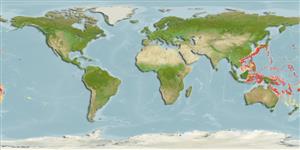Environment: milieu / climate zone / depth range / distribution range
Ecologia
marinhas demersal; intervalo de profundidade 148 - 956 m (Ref. 116586). Tropical
Disjunct distribution: Northwestern Pacific off southern Japan, Taiwan and the northern Philippines and Southwestern Pacific from the Coral Sea to Vanuatu; none from the tropical low latitudes.
Tamanho / Peso / Idade
Maturity: Lm ? range ? - ? cm
Max length : 11.0 cm SL macho/indeterminado; (Ref. 116586)
Descrição breve
Chaves de identificação | Morfologia | Morfometria
Espinhos anais: 3; Raios anais moles: 6. This deep-bodied species is distinguished by the following characters: convex dorsal head profile; A III + 6 in >6.5 cm SL specimens; pectoral-fin rays 16-18 with length 21.5-27% SL; gill rakers 15-18; pseudobranchial filaments 16-23, increasing with size; first anal-fin pterygiophore is long, slightly forward bent, with very broad tip and hollow; ectopterygoid with a single row of denticles; orbit diameter 11.7-13.3% SL; otolith compressed (OL:OH = 1.45-1.55) (Ref. 116586).
Found on the continental slope (Ref. 75154).
Life cycle and mating behavior
Maturidade | Reprodução | Desova | Ovos | Fecundidade | Larvas
Schwarzhans, W.W. and A.M. Prokofiev, 2017. Reappraisal of Synagrops, Günther, 1887 with rehabilitation and revision of Parascombrops Alcock, 1889 including description of seven new species and two new genera (Perciformes: Acropomatidae). Zootaxa 4260(1):1-74. (Ref. 116586)
Categoria na Lista Vermelha da IUCN (Ref. 130435: Version 2024-2)
Ameaça para o homem
Harmless
Utilização humana
Ferramentas
Relatórios especiais
Descarregue XML
Fontes da internet
Estimates based on models
Preferred temperature (Ref.
123201): 15.3 - 26.8, mean 22.3 °C (based on 220 cells).
Phylogenetic diversity index (Ref.
82804): PD
50 = 0.5001 [Uniqueness, from 0.5 = low to 2.0 = high].
Bayesian length-weight: a=0.00977 (0.00436 - 0.02192), b=3.01 (2.81 - 3.21), in cm total length, based on LWR estimates for this (Sub)family-body shape (Ref.
93245).
Nível Trófico (Ref.
69278): 3.5 ±0.5 se; based on size and trophs of closest relatives
Fishing Vulnerability (Ref.
59153): Low vulnerability (10 of 100).
